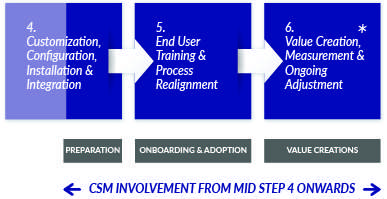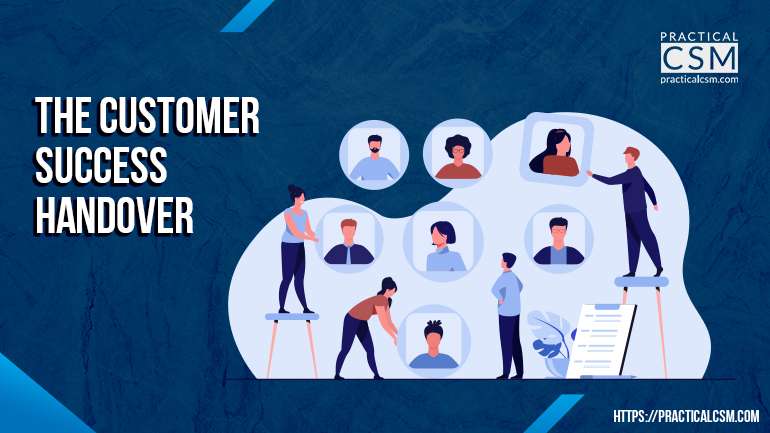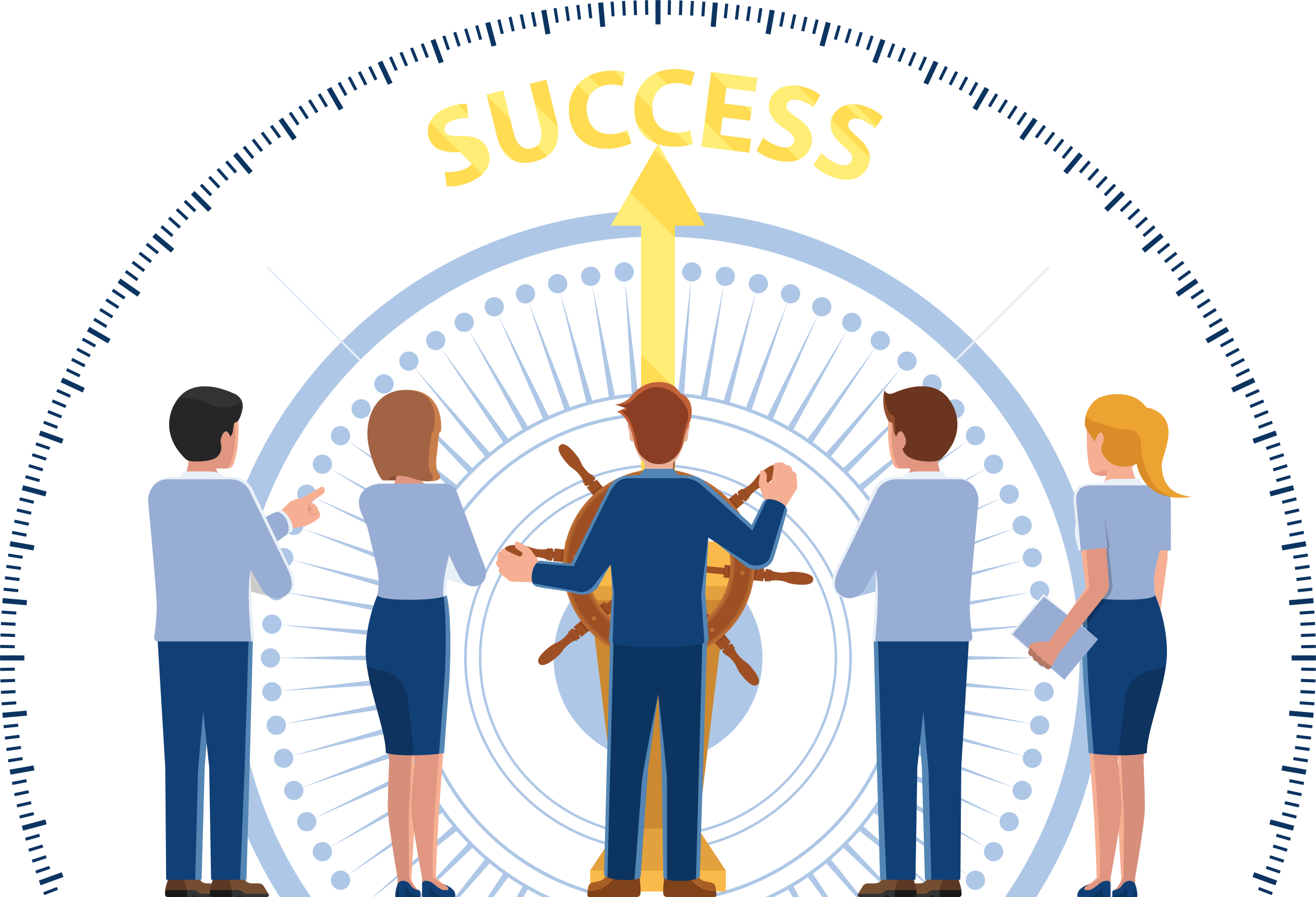The Customer Success Handover
Overview
Of course every customer and each customer engagement will be somewhat different, but whilst there will be variation in detail between customers and engagements, the process of engaging with customers is likely to remain the same or similar each time. Because of this, the way to prepare for this process of engagement can be reasonably well defined and documented ahead of time.
It is true to say that good preparation will make a big difference to both the quality of the outcomes obtained from the engagement and the efficient use of time and other resources in getting to those outcomes. In this sense a customer engagement is no different from any other project which has at least some level of complexity. Whether you are redecorating the living room, launching a new product, performing heart surgery or helping a customer obtain value from the products, services and solutions they have purchased from you, the secret to a great result lies in good preparation. I would suggest that for every hour you spend in good quality preparation activities you may well save three to five hours of your own and your customer’s efforts further down the line.
What types of preparation activities might a CSM look to accomplish when readying themselves for a new customer engagement? The focus of their efforts should be on getting a profound enough understanding of what is going on to become immediately useful to the customer before they start meeting with the customer. To do this they need to spend some time in conversation with those colleagues (and with partners if applicable) who have already been involved in the customer engagement to date, and in reviewing information recorded on corporate systems and tools, and possibly in uncovering additional information from elsewhere as well. They then need to assemble and compile this information into some sort of logical order so they can review and make sense of it. Finally they need to make themselves a plan of action for the, based upon the level of understanding about the engagement that they now have.
The Importance of Smooth Transitions
From the customer’s standpoint what they ideally want is an elegant and transparent transition between each step in order to maximize the quality of the end result and reduce the effort involved in getting there. What they do not want to experience is a lack of communication between different teams or worse still any friction between them as they “hand the customer over” between each step. Neither do they wish to be left hanging without any support and wasting precious time and money whilst the vendor or other sales company gets their act together to provide the relevant people and resources for the next stage. The customer wants a smooth and joined up transition between stages so that they do not experience any frustration through unnecessary waiting or having to re-explain their requirements to a new set of people before those people become useful.

The CSM needs to be aware of this, and should do their best to ensure they are apprised of any customer engagements that are currently in step 4 and which they will be the CSM for when the customer is transitioned to step 5. If the CSM knows which customers are in step 4 then they can utilize the time that the customer is in this step to prepare themselves for their engagement with the customer in step 5. In this way when step 5 finally happens the CSM is already well prepared and able to hit the ground running. No time is wasted, the customer’s frustration level is reduced, their satisfaction level is increased and value is realized that much sooner for all concerned. Fig 2 below focuses on the parts of the overall customer engagement that the CSM is involved with and shows how the phases within the PCSMF fit to the steps in this engagement.

Talking to the Pre-Adoption Team
The first port of call for most CSMs who are looking for information about the customer, the initiative, the solution that was purchased, and the progress that has been made to date should be their colleagues who have already been involved in the engagement. This includes but is not necessarily limited to those people who were involved in the sales process. In addition to the sales process it might also involve people who were involved in design, custom development or other customization, installation, integration, configuration, and the provision of professional and managed services.
The AM (account manager) or other sales person is the obvious start point in talking to the pre-adoption team. This is because the sales person for a particular customer is generally easy to identify and because the account management role requires this person to have a good overall understanding of all aspects of the engagement. The sales person can usually therefore both provide the CSM with a thorough briefing about most aspects of the customer engagement and serve as an excellent source of information as to who else the CSM should go to in order to collect any additional information that may be required.
Here are some ideas for the type of information you might want to obtain from them in a customer success handover:
| Topic | Description |
| Customer Information |
Basic customer information including name, contact details and some background on what they do, where and how they operate, who their customers are, what type of relationship we have with them, etc |
| Solution and contract information |
A description of the products and services that were sold together with any customization, configuration or other professional services sold alongside them and any important contract terms including deadlines, qualities, duration, etc. |
| Customer outcome requirements |
The required or anticipated outcomes from the solution that were specified by the customer or assumed by us, and a breakdown of any outcome commitments that were made by us. Information about any agreed measurements, milestones and deadlines |
| Our outcome requirements |
An understanding of the deal value, both immediate and predicted over the lifecycle term. An understanding of any other anticipated or desired outcomes such as contract size increases, additional sales, and/or advocacy |
| Stakeholder information |
A breakdown of the people who have been, are and will be involved in the engagement on both sides (us and customer) |
| Third parties |
Information about any third party organizations who are also involved in the project and a summary of their involvement |
| Project status |
A summary of the current situation together with any agreed activities and deadlines moving forwards. An understanding of how well the project has gone thus far and any known problems |
| Key supplier contact information |
A list of essential contacts relating to each product and service that is contained within the solution that the customer has purchased, including those from third parties |
| Existing meeting and reporting arrangements |
An understanding of how often customer meetings have taken place and their style and format. An understanding of what information is already being reported to the customer and how thus information is formatted and presented |
| Processes for handling problem resolution | An understanding of how technical support and problem resolution services are provided, together with relevant contact details and authorization information |
The Value of Good Internal Relationships
A final thought on this important topic. Managing people is a critical skills for all CSMs to have. We often think of people management (or stakeholder management) as being all about managing the relationships we have with the customer, but the management of relationships with others within our own company is equally if not even more important, since we will potentially need to work with those people on many different customer engagements on into the future.
Whenever you meet other people it is important to recognize they are indeed people, not automatons. This means they come with emotions and feelings, and with pre-conceived opinions and judgements. They may for example be suffering under the stress of a particularly heavy workload right now, or struggling to meet important role-based targets that direct impact their remuneration. Additionally they may not understand the role of the CSM or recognize the value that customer success management can deliver to the customer and potentially to themselves. In fact for some of your colleagues they may even see the CSM as a threat to their own success.
Many AMs, sales specialists, design architects, service managers, consultants and other members of the pre-adoption team are likely to be well educated in the value the customer success management brings and are very happy to work closely with CSMs in their customer engagements. However you need to be aware of potential issues within your own organization where colleagues may not understand the purpose and value of customer success management and may even perceive it as a threat to their own personal success. Where problems do exist, you won’t necessarily be able to fix these problems – and certainly not overnight – but by making yourself aware of them you can plan to deal with them as best you can by engaging the necessary resources for problem resolution.
Sometimes it may be lack of education about customer success management that is causing the problem. Other times it may simply be a lack of time available or an unwillingness to share information. Whatever the case, the CSM needs to think about how they can present their role and the benefits it brings to both customer and your own company to those colleagues who are not yet familiar with this information, so that they understand both that it is of value to them and to the customer and that it does not threaten their own position. Most importantly you need to make sure you show the value of working with the CSM to that person in the role they occupy. Where a difficult relationship exists, try to make it easy for them to do what you want them to do. If that means you travelling out to meet them where they happen to be, or you fitting in an awkward meeting time when they happen to be free then so be it. Remember that at this stage in the proceedings it is you who wants something from them, not the other way around. Of course as your customer success organization matures and becomes a valued fixture within your company’s overall structure, your colleagues from other parts of the business will start to see customer success in its true light, and treat it accordingly. So if this issue does arise for you, consider it as a temporary problem – one that will only occur during the initial “bedding in” process that is perhaps an inevitable concomitant of the newness of the customer success role.







